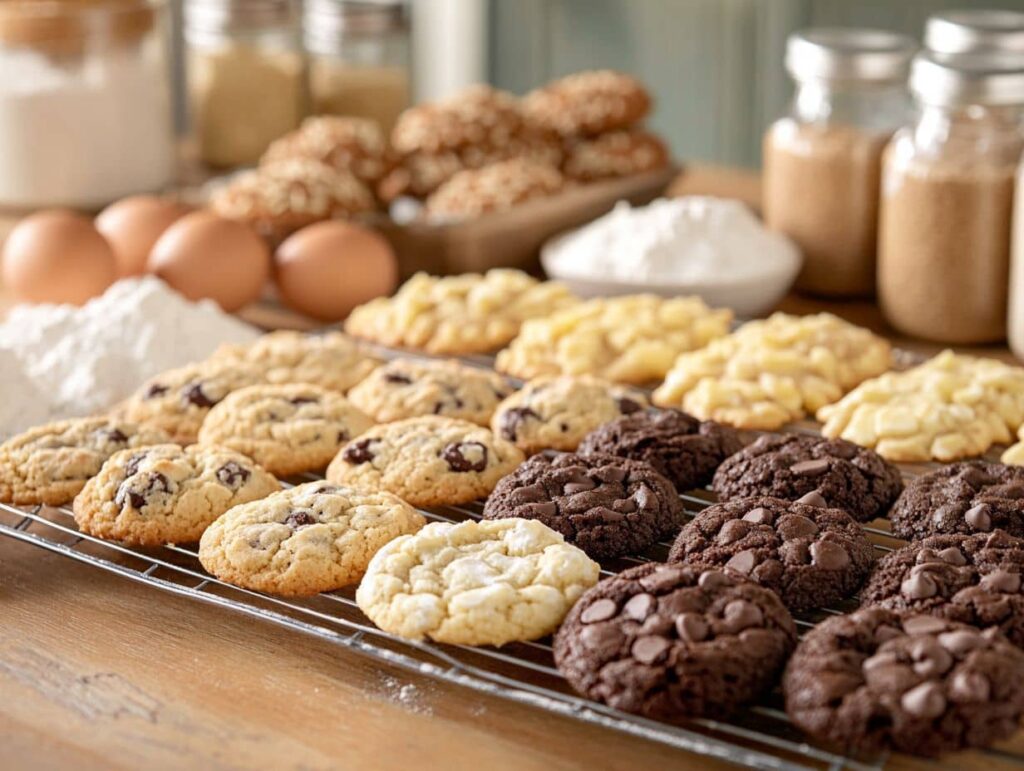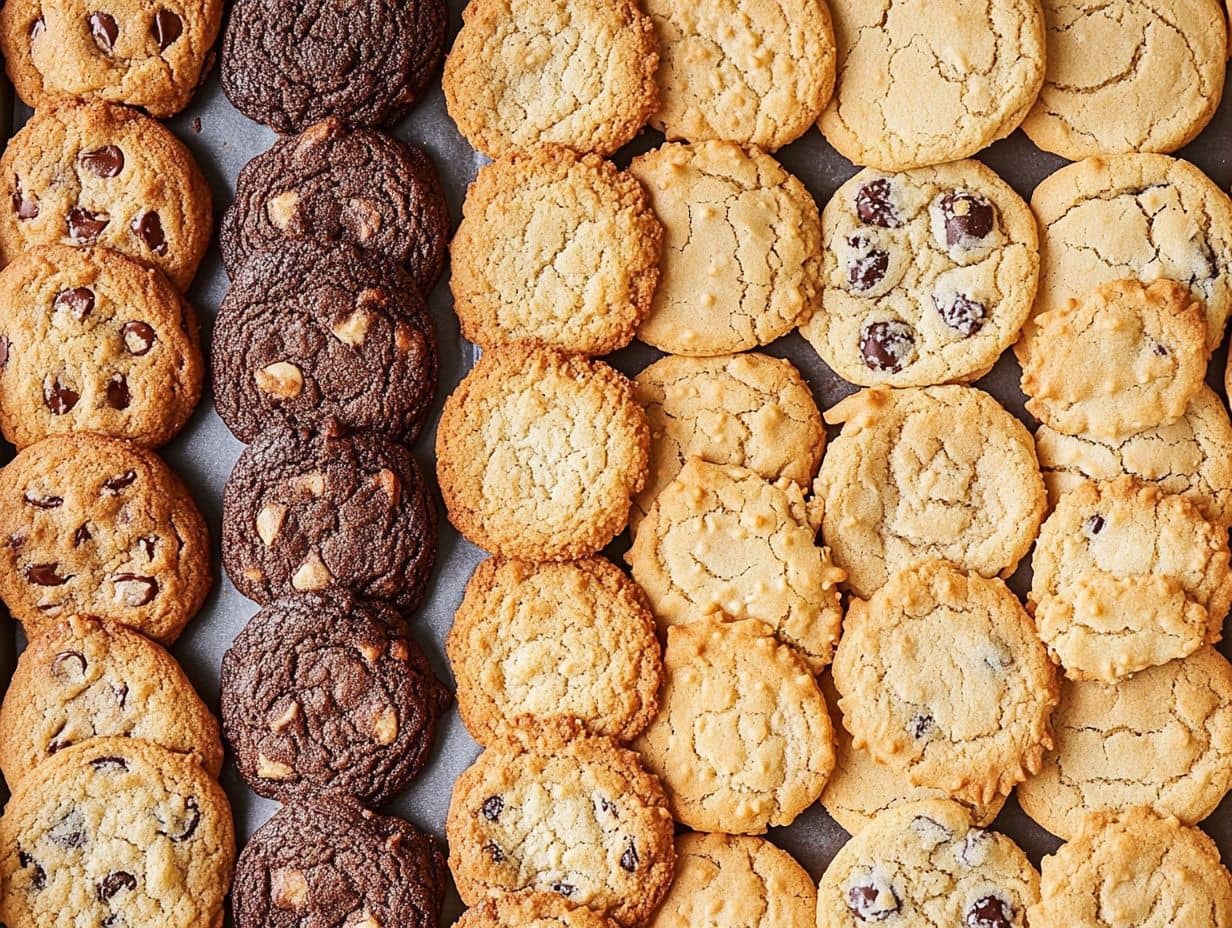Have you ever wondered how many cookies are in one batch when following a recipe? If you’re someone who loves baking, or even if you’re just a casual cookie eater, you’ve probably heard the term “batch” tossed around in recipes. But what exactly does “1 batch” of cookies mean, and how many cookies does it actually make? In this article, we’re going to break it down in a fun and simple way so you can understand how cookie batches work, how to manage them in the kitchen, and how to make the perfect batch every time! 🍪
Introduction: Understanding Cookie Baking Terminology
Baking might seem like an art form, and while it definitely has some creative elements, there’s a lot of science behind it as well! One of the basic terms you’ll come across is “batch,” which simply refers to the amount of cookies (or dough) you make in one go. But here’s the thing the number of cookies in one batch can vary depending on the recipe, the size of the cookies, and even the equipment you’re using. So, before you jump into baking, it’s helpful to understand what you’re working with.
If you’re wondering, ‘What does 1 batch of cookies mean?’ this article will answer all your questions! If you’re curious about how long a batch of cookies lasts, this article dives deeper into storage and freshness tips.
Table of Contents
What is a Cookie Batch?
Definition of a Batch in Baking
In baking, a “batch” is simply the total amount of dough or mixture you prepare at once. Whether you’re making cookies, brownies, or cakes, the batch size refers to how much you’re going to bake at one time. When a recipe calls for “1 batch of cookies,” it’s referring to the complete amount of cookie dough or batter that you’ll bake in one session, usually in a single batch of cookies at a time.
Let’s break it down further: Imagine you’re following a recipe that calls for 2 cups of sugar, 3 cups of flour, and a handful of other ingredients. When you combine them together, that’s one batch of dough. But the number of cookies it yields depends on the size of the cookies you’re baking. Some recipes might tell you how many cookies you’ll get from one batch, while others might leave it to you to decide based on the size of your cookie scoops.
Depending on cookie size, you can scale the recipe to create a small batch of chocolate chip cookies for fewer servings.
How a Batch Relates to Cookie Recipes
When you bake cookies, recipes typically assume that you’re making one batch at a time, and they provide the necessary quantities of ingredients for that specific amount. For example, a standard chocolate chip cookie recipe might call for one batch, meaning it’s designed to make a specific number of cookies – often around 24 if you’re using a standard tablespoon-sized scoop. But if you’re wondering, ‘What does 1 batch of cookies mean?’ you should know that you can scale the recipe up or down depending on your needs. Let’s say you’re craving a big cookie, and the recipe gives you a batch yield of 24 cookies. If you want fewer, you could make bigger cookies and only get 12 from the batch. If you’re interested in tweaks for softer cookies, explore the secret ingredient to keep cookies soft.
The Standard Size of a Cookie Batch
So, how many cookies are in a standard batch? Well, the answer depends on the recipe you’re using, but there are some general rules. Most cookie recipes assume you’re making 1 batch of cookies, which typically results in 24 cookies. This is based on using a standard tablespoon to scoop your dough, which produces cookies about 2 inches in diameter. If you’re making cookies smaller or larger, the number of cookies you can expect from a batch will change. Let’s dive into that! 👇
How Many Cookies Does 1 Batch Make?
As we just mentioned, the standard batch size for cookies is often around 24 cookies. But why 24? It’s all about proportions. Most recipes are designed so that the dough can be divided into 24 equal portions. When you use a tablespoon to scoop the dough, you’re getting a relatively uniform cookie size, and 24 cookies is a great starting point for most home bakers.
However, if you’re making large cookies think giant cookies that are the size of your hand your batch might only produce 12 cookies. On the flip side, if you’re making tiny bite-sized cookies, you could end up with 48 or more from one batch. The cookie size you go for can dramatically impact how many cookies you’ll get.
Variations in Batch Size for Different Cookie Recipes
While 24 cookies is the general rule of thumb for most recipes, not all cookie doughs are created equal. Some cookie recipes – like those for delicate cookies such as shortbread – may result in slightly fewer cookies because the dough is denser or requires more precise measurements. On the other hand, cookies that spread out a lot in the oven (think chocolate chip cookies with a lot of butter) may yield more cookies per batch, especially if you’re using a smaller scoop size.
For example, some recipes for thin, crispy cookies might result in over 30 cookies from a single batch, while others designed for thick, chewy cookies might give you fewer than 20. So, the yield from a batch isn’t always fixed – it depends on the recipe, ingredients, and how you shape the dough. 🍪
Nutrition Facts for 1 Batch of Cookies
Now, let’s talk about something that’s often on our minds when we bake: the nutritional value! If you’re planning to bake a batch of cookies, it’s always good to know what you’re putting into your body. Here’s a simple table that shows the nutrition facts for a standard batch of chocolate chip cookies (based on 24 cookies per batch). Keep in mind that the nutrition facts can change depending on the recipe and ingredients used.
| Ingredient | Quantity |
|---|---|
| Flour | 2 1/4 cups |
| Sugar | 3/4 cup |
| Butter | 1 cup |
| Chocolate Chips | 2 cups |
| Eggs | 2 large |
Now, let’s break down the nutritional value for one standard cookie from the batch:
| Nutrition | Per Cookie |
|---|---|
| Calories | 200 |
| Fat | 10g |
| Sodium | 120mg |
| Carbohydrates | 28g |
| Sugar | 18g |
| Protein | 2g |
Now you have a general idea of what to expect nutritionally when you bake a batch of cookies! Just remember, these numbers can change based on your ingredients, so always check the recipe you’re using.
Factors That Affect the Number of Cookies in a Batch
When it comes to baking cookies, there are a few key factors that can change the number of cookies you’ll get from one batch. These include the size of the dough balls, the spacing between them on the baking sheet, and even the temperature of your oven. Let’s explore these factors to help you manage your cookie batches better.
Cookie Dough Consistency and Size
One of the most important factors that influence how many cookies come out of a batch is the consistency of your dough and the size of the dough balls you form. For instance, if you make smaller dough balls, you’ll get more cookies out of a batch. But if you’re asking yourself, ‘What does 1 batch of cookies mean?’ it’s helpful to know that if you prefer big, chunky cookies, the number of cookies per batch will naturally be fewer.
It’s important to note that the texture of your dough plays a big role too. Some cookie doughs are thick and dense, which means the cookies spread less and end up being thicker. These thicker cookies might give you fewer per batch because you need more dough for each one. On the other hand, a thinner dough might spread out more, and you’ll end up with more cookies that are crispier and thinner
Oven Size and Temperature Considerations
The size of your oven and its temperature can also affect how many cookies you can bake at once. In a standard home oven, you can usually fit 2-3 cookie sheets at a time, depending on the size of your baking sheets and your oven’s space. If you’re using a smaller oven or a toaster oven, you might only be able to bake one sheet at a time.
Another important thing to remember is the temperature. If your oven runs hotter than the recipe recommends, your cookies might bake faster, but they could also be more spread out or uneven. On the other hand, if your oven is cooler, the cookies might not spread enough, resulting in thicker cookies and potentially fewer of them. Make sure to check your oven’s temperature with an oven thermometer to ensure accuracy!
Cookie Shape and Spacing on the Baking Sheet
One of the most important factors that influence how many cookies come out of a batch is the consistency of your dough and the size of the dough balls you form. For instance, if you make smaller dough balls, you’ll get more cookies out of a batch. But if you’re asking yourself, ‘What does 1 batch of cookies mean?’ it’s helpful to know that if you prefer big, chunky cookies, the number of cookies per batch will naturally be fewer.
It’s important to note that the texture of your dough plays a big role too. Some cookie doughs are thick and dense, which means the cookies spread less and end up being thicker. These thicker cookies might give you fewer per batch because you need more dough for each one. On the other hand, a thinner dough might spread out more, and you’ll end up with more cookies that are crispier and thinner.
Solutions to Common Cookie Batch Problems
Don’t worry if you’ve encountered any of these issues we’ve got solutions for each one! Let’s take a look at some simple fixes for common baking problems.
Properly Spacing Cookies on the Baking Sheet
Spacing your cookies properly is one of the easiest ways to ensure they bake evenly. As we mentioned earlier, aim for about 2 inches between each cookie. This gives them enough room to spread out and bake without merging. If you’re using a larger baking sheet, you can fit more cookies without crowding them.
Using the Right Bakeware for Even Heat Distribution
The type of bakeware you use can also impact your batch of cookies. Darker baking sheets tend to absorb more heat and can cause the bottoms of your cookies to brown too quickly. On the other hand, shiny or light-colored sheets reflect heat, which can result in a more even bake. Choose bakeware that works best for your oven.
Adjusting Baking Time for Larger or Smaller Batches
When you scale up or down the size of your batch, you may need to adjust the baking time. Larger cookies may need a bit more time in the oven, while smaller cookies bake faster. Just keep an eye on them, and start checking for doneness a couple of minutes before the recommended time is up.
How to Adapt a Recipe for Different Batch Sizes

Sometimes, you might need more cookies than a recipe’s batch yields, or maybe you’re baking for just one or two people and want a smaller batch. Whatever the reason, adjusting the batch size to suit your needs is actually pretty simple once you understand the basics. Let’s talk about how you can adapt a cookie recipe to fit larger or smaller quantities.
Doubling or Halving the Batch Size
One of the easiest ways to change the number of cookies you’re making is by doubling or halving the recipe. If you’re baking for a large crowd or have a big cookie craving, doubling the recipe is a great way to go. But if you’re only making a few cookies or don’t want to end up with too many leftovers, halving the recipe is your solution.
For example, if a recipe calls for 2 cups of flour, 1 cup of sugar, and 1 cup of butter to make 24 cookies, doubling the recipe will give you 48 cookies. On the flip side, halving it would result in only 12 cookies. Easy, right? Just make sure to adjust all ingredients proportionally!
Converting Ingredient Amounts for Smaller or Larger Batches
When you adjust the batch size, it’s important to convert the ingredient amounts correctly. For example, if you’re scaling up a recipe by 1.5 times, you’ll need to multiply each ingredient by 1.5. If you’re halving the batch, just divide the ingredients by 2. It’s a simple math trick that ensures your cookies maintain their perfect texture and flavor.
Keep in mind that when scaling recipes, you might also need to adjust the baking time. Larger batches might take a little longer to bake, and smaller batches could need less time in the oven. Keep an eye on your cookies, and check them a couple of minutes before the timer goes off to avoid overbaking.
Best Practices for Efficiently Baking Multiple Batches of Cookies
If you’re baking several batches of cookies, it helps to have a strategy to make the process as smooth and efficient as possible. Here are some tips to make your batch baking experience less stressful and more enjoyable.
Prepping Dough in Advance
One of the best tips for baking multiple batches of cookies is to prep your dough in advance. Whether you’re baking the same kind of cookies for a few days or you’re prepping dough for a big cookie party, making the dough ahead of time can save you a lot of work.
Simply mix your dough, portion it into balls, and store it in an airtight container in the fridge or freezer. When you’re ready to bake, just pull the dough out and pop it on the baking sheet! This also helps prevent the dough from getting too soft as it sits out at room temperature, giving you better control over the cookie’s shape.
Organizing Your Workstation for Batch Baking
Keeping your kitchen organized when you’re baking multiple batches of cookies can make the whole process feel easier. Start by lining up your baking sheets and having your cooling racks ready. If you have multiple trays, get them all ready to go so you can quickly move from one batch to the next.
Having everything organized also helps with prep time. If you’ve pre-measured your ingredients, it’s easy to whip up dough for each batch in just a few minutes. If you’re making different types of cookies, it helps to clean up between batches to avoid mixing flavors.
Conclusion: What does 1 batch of cookies mean?
So, now you know what 1 batch of cookies means and how to make it work for you in your kitchen! A “batch” typically refers to the quantity of cookies a single recipe yields, which can vary depending on the recipe’s proportions and the size of the cookies. Whether you’re baking a standard batch for yourself or scaling it up for a party, understanding the science and art of cookie batch baking can help you create delicious treats every time.
Remember, the key to perfect cookies is all about balance: the right ingredients, proper dough consistency, and attention to details like spacing and baking time. Don’t be afraid to experiment with batch sizes, adjust your ingredients, and even freeze some dough for later use. Happy baking, and may your cookies always come out perfectly!
If you’d like to explore more cookie-related tips and tricks, check out articles on how to make cookies softer or smaller batches for quick treats.

